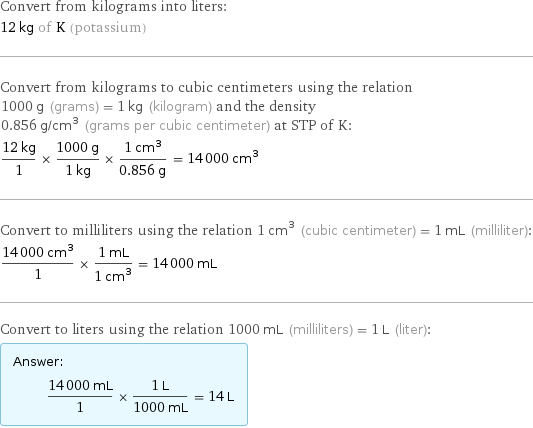Input interpretation

convert 12 kg of potassium (chemical element) to volume
Results

14 L (liters)
Possible intermediate steps

Convert from kilograms into liters: 12 kg of K (potassium) Convert from kilograms to cubic centimeters using the relation 1000 g (grams) = 1 kg (kilogram) and the density 0.856 g/cm^3 (grams per cubic centimeter) at STP of K: (12 kg)/1 × (1000 g)/(1 kg) × (1 cm^3)/(0.856 g) = 14000 cm^3 Convert to milliliters using the relation 1 cm^3 (cubic centimeter) = 1 mL (milliliter): (14000 cm^3)/1 × (1 mL)/(1 cm^3) = 14000 mL Convert to liters using the relation 1000 mL (milliliters) = 1 L (liter): Answer: | | (14000 mL)/1 × (1 L)/(1000 mL) = 14 L
Unit conversions

0.014 m^3 (cubic meters)

14000 cm^3 (cubic centimeters)

29.6 pints

14.8 quarts

3.7 gallons

0.495 ft^3 (cubic feet)

855 in^3 (cubic inches)
Comparisons as volume

≈ ( 0.006 ≈ 1/150 ) × volume of paint needed to cover the outside surface of the White House ( ≈ 600 gal )

≈ 0.63 × volume of one mole of ideal gas at 273.15 K and 101.325 kPa ( 0.02241 m^3 )

≈ 2.5 × volume of a soccer ball ( 5310 to 5792 cm^3 )
Comparisons as volume of food or beverage

≈ 4.5 × volume of a US size 10 can ( 105 fl oz )

≈ 8.5 × volume of a US size 5 can ( 7 cups )

≈ 270 × volume of a standard US large egg ( 3.5 tbsp )
Interpretations

volume

volume of food or beverage

section modulus
Basic unit dimensions
![[length]^3](../image_source/a8dc3569aecee6c418918ebec9f09825.png)
[length]^3
Corresponding quantities

Radius r of a sphere from V = 4πr^3/3: | 15 cm (centimeters) | 0.49 feet | 5.9 inches

Edge length a of a cube from V = a^3: | 24 cm (centimeters) | 0.79 feet | 9.5 inches

Mass m of water from m = ρ_(H_2O)V: | 14 kg (kilograms) | 31 lb (pounds) | (assuming maximum water density ≈ 1000 kg/m^3)

Molecule number N of water from N = ρ_(H_2O)V/m_(H_2O): | 4.686×10^26 molecules | (assuming maximum water density ≈ 1000 kg/m^3) | (assuming molecular mass of water ≈ 18.02 u)